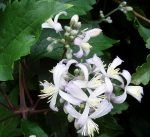
This deciduous semi-shrub/climber is a hybrid between C. vitalba and C. heracleifolia var. davidiana and is a member of the buttercup family, ‘Ranunculaceae, that also includes monkshood, columbine, and hellebore. It has strongly ribbed, slightly downy stems up to 10′ long and quickly grows along the ground, forms a 3’ tall sub-shrub, or climbs. The pinnately compound leaves have 3-5 leaflets that are coarsely-toothed and 2-4″ long. One to two foot long compound panicles of mildly fragrant flowers appear from late summer into fall. Each flower is up to 2″ across and has 4-6 strap-shaped petal-like sepals that are yellowish-white turning creamy-white inside and lavender-white outside and at the tips. Jouin clematis is good in a border, as a ground cover, or growing over a wall, tree stump, or garden structure. The genus name, Clematis, is from the Greek word klematis, the name for climbing plants in general. The hybrid name, jouiniana, honors E. Jouin, manager of the Simon-Louis nurseries at Metz. The cultivar name, ‘Praecox’, comes from the Latin prae- meaning before, and coquere, meaing to cook, and means ripen early, an odd choice considering that the plant blooms late relative to other Clamatis’ and plants in general.
Type: Deciduous semi-shrub/climber
Bloom: Panicles of small white tinged with lavender flowers from late summer into fall
Size: 3-10′ H x 3-6′ W
Light:Full sun to partial shade
Soil: Average, mediummoist, well-drained
Hardiness: Zones 4-8
Care: Plant so that roots and cool and moist; prune back in fall or late winter’ mulch in late winter
Pests and Diseases: Aphids, caterpillars, earwigs, scale, slugs, snails, spidermites, vine weevils; clematis wilt, leaf spot, powdery mildew, rust, viruses;
Propagation: Layering, division, basal stem cuttings
Photo Credit:Wikimedia Commons